ABS AUDI A3 2011 Owner´s Manual
[x] Cancel search | Manufacturer: AUDI, Model Year: 2011, Model line: A3, Model: AUDI A3 2011Pages: 320, PDF Size: 75.79 MB
Page 14 of 320

Instruments and warning/indicator lights
Glow plug system (diesel engine only) ~page 13
(alternative to )
Electronic stab ilizat ion program (ESP) ~ page 14
USA models : ~page 14
Malfunction Indicator lamp (MIL)
Canada models: ~page 14
Malfun ction Indictor Lamp (MI L)
-o H igh beam ~page 14
¢ Left turn signal ~page 14
--
~
Right turn signal ~page 14
Ele ct ronic St abili zation Program ( ESP) ~page 14
CRUISE
USA models :
Cruise control activated ~page 14
0
Canada models:
Cruise contro l a ct ivate d
~page 14
.o.
,::::..fJ Airbag system ~page 15
0 Genera tor ~page 15
~
Safety belt ~page 15
BRAKE
USA models:
Bra ke system, parking brake set ~page 15
CCD> Canada models:
Brake system, parking bra ke set
-
-
-
~ page 16 USA models:
Anti-loc k bra ke system (ABS)
Canada models : ~page 16
Anti-lock brake system (ABS)
/ @ Electr o-m ech anical power assist ~ page 17
& WARNING
• Failure to heed warning light s and other important vehicle
information may result
in serious personal injury or vehicle
damage.
• Whenever stalled or stopped for repair, move the vehicle a safe
d istance off the road, stop the engine, and turn on the emergency
fla sher ~
page 59.
• The engine compartment of any motor vehicle i s a potentially
hazardous area. Before you check anything in the engine compart
ment , stop the engine and let it cool down. Always exercise
extreme caution when working under the engine hood
~ page 218, " Engine compartment"
[ i ] Tips
• When a yellow war ning symbol appears, one warn ing tone
so unds. C hec k the fun ction d isp laye d a s soo n as poss ible.
• When a red symbol appears,
three warning tones sound in succes
sion . The symbol continu es to flash until the fa ult has been
corrected. •
App lies to vehicles : w ith Au di magnetic r ide
Audi magnetic ride
The indicator ligh t monitors vehicle damping.
Th e indica tor lig ht illum ina tes w hen the ig nit io n is switched on as a
function check. _,,,
Page 16 of 320

Instruments and warning /indicator lights
Electronic Stabilization Program (ESP}
r /
The warning/indicator light monitors the electronic
stabili zation program.
The warning/ind icator light ,., has the following functions:
• it flashes wh ile you are drivi ng, when the ESP or the ASR (Ant i-Slip
Regulation) is working .
• it ill um ina tes when yo u sw itc h on the ignition for app rox imately 2
seconds as a funct ion check .
• it illum inates w hen there is a malfunction in the ESP .
• it illum inates after the battery has been disconnected.
• it illum inates continuously when the ESP is switched off.
• it illumi nates if the re is a malfunct ion in t he ABS, s ince the ESP is
part of the ABS system.
If the ESP warning/ind icator light ill umina tes and stays on after you
have started the engine, this may mean that the co ntro l system has
tempo rari ly switched off the ESP. If this is case , you can reactivate
the ES P by sw itch ing t he ig nit ion off and the n on agai n. The
warning/indicator light should go out to show that the system is fu lly
fu nctional again .
The ESP warn ing/ind icator light will illuminate when the ignition is
switched on if th e ve hicle bat tery has been disconnected and the n
reconnected aga in . The light should go ou t after dr iv ing a short
dis tance if the steer ing whee l is turned s lig htly.
For mo re information abo ut the ESP=>
page 188 . •
Malfunction Indicator Lamp (MIL}
(USA models}/ (Canada models}
The Malfunct io n Indicator Lamp ( MIL) is part of the On -Board D iag
nos tic (O BD II) system. The symbol ligh ts up w hen the ign ition is
turned on and w ill tu rn off after the eng ine has star ted and has sett
led at constant idle speed . This i nd icates that the MIL is work ing
properly .
T he warn ing light ill uminates when there is a malfunction in the
engine e lectronic system. Contact yo ur a uthorized Audi dealer and
have the malfu nction co rrec ted .
For more information=>
page 20. •
High beam !§"0
T he ~D warning/indicator light illuminates when the high beams are
on or whe n yo u us e the headl ight flasher. Fo r more informat io n abou t
using the high beams, see=>
page 59. •
Turn signals ¢¢
The indicator li ght flashes when you use either tur n
signal .
Whenever yo u use the left¢ or the right¢ tu rn signa l, the indicator
light flas hes. W hen you use t he emerge ncy f lashe r, both ind icator
lights flash.
If one of the turn sign al ligh t bul bs bur n ou t, the turn signal will flash
twice as fast as normal. •
Cruise control
CRUISE (USA models}/ 0.z (Canada models}
The CRU ISE warning/indicator light illuminates when the cruise control
is activa ted. •
Page 17 of 320

Airbag system !.!r
This warning/indicator light monitors the airbag and the
tensioner systems.
The !! r warning light i llum inates for a few seconds each time you
switch on the ign ition.
If the
! !r warning light does not go out, or if it illum inates while you
are d riving, or i f it s tarts to flash, t hen there is a m alfu nct io n some
where in the system . If the light does not illum inate when you switch
on t he ignition, this also means there is a malfunction.
& WARNING
If you have a malfunction in the airbag sy stem, contact your
authorized Audi dealer immediately. Otherwise the airbag or the
belt tensioner ma y not work properly in an accident. •
Generator 0
This warning/indicator light detects a malfunction in the
generator or in the vehicle 's electrical syst em .
Th e D war ning/in dica tor lig ht ill uminates when you swit ch on t he
ign ition and must go out a fter the engine has started.
If the D war ning/ind ic at or ligh t illumina tes whi le you are d riving,
you shou ld contact you r auth o rized Audi dealer . Since the ve hicle
battery is discharging, you shou ld switch off any unnecessary elec
t rical consume rs (fo r example , the air condi tioner) .•
Controls and equip
ment Safety first
Instruments and warning
/indicator lights
Safety belts ,ft-
This warn ing/indic ato r light remind s you t o put on yo ur
safety belt.
The 4'-wa rning/ind icator light illuminates when the ignition is
s w itched on to re mi nd the driver and (o n USA models only) any fro nt
passenger to put on the sa fety belt. Additionally, an acoustic warn ing
(gong) will a lso s oun d.
For more Information=>
page 135, "Safety belt wa rning light .t" . •
Brake system
BRAKE (USA)/ (CD) (Canada)
T his warn in g/in dic ato r ligh t ill umin ates whe n t he br ake
flui d level is t oo lo w o r w he n t here is a ma lfunction in the
AB S, or whe n the pa rking b rake is s et.
T he light illuminates w hen the ign it io n is tu rned on . It goes out after
t he engine has bee n sta rted and th e p arki ng bra ke is f ully re le ase d.
T hi s indicates that t he bra ke warning light is functioning properly.
If the brake warning light does not light up when the engine is
cranking or the parking brake is appl ied , there may be a malfunc
tion in the electrical system. In this case , contact your Audi dealer .
If the ABS f ails, the A BS war ning/ indicato r light 5 (USA
models)/ (Canada mode ls) flashes toget her w it h the brake system
w ar ning/indica tor ligh t=> & .
(USA models): If the warning light
BRAKE and the warni ng lig ht illu
m inate together, immediate ly contact your authorized Audi dealer or
qualified workshop to have all brake pads inspected=>
page 35.
Whe n the light comes on, an aud ible warn ing si gna l is also given .
Parking brake set
The BRAKE warning/indicator light i lluminates when the par king brake
is set=> &. _,.
Vehicle care Technical data
Page 18 of 320
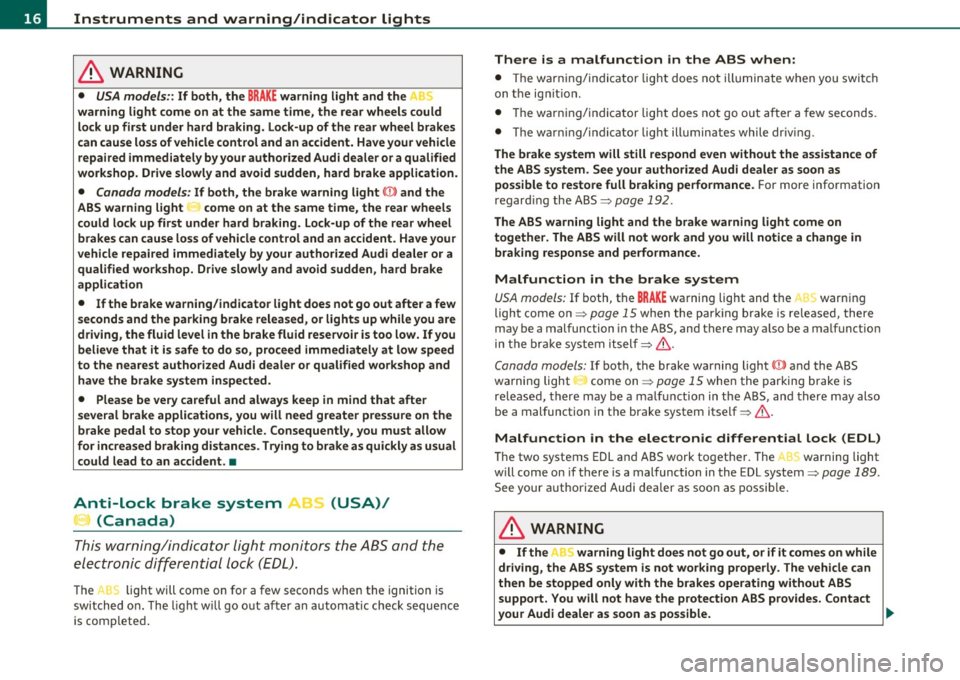
Instruments and warning/indicator lights
in. WARNING
• USA models: : If both, the BRAKE warning light and the
warning light come on at the same time, the rear wheels c ould
lo ck up fir st under hard braking . Lo ck-up of the rear wheel brakes
c a n cause loss of vehicle control and an accident. Have your vehicle
repaired immedi ate ly by your authorized Audi dealer or a qualified
workshop . Drive slowly and avoid sudden , hard brake appli cation .
• Canada models : If both, the brake warning light ((j)) and the
ABS warning light
~ come on at the same time , the rear wheels
could lock up first under hard braking . Lock-up of the rear whee l
brakes can cause loss of vehicle control and an accident. Have your
vehicle repaired immediat ely by your authorized Audi dealer or a
qualified work shop. Drive slowly and avoid sudden, hard brake
application
• If the brake warn ing/indicator light does not go out after a few
se cond s and the parking brake rel eased, or light s up while you are
driving , the fluid level in the brake fluid reservoir is too low. If you
believe that it i s safe to do so, proceed immediately at low speed
to the nearest authorized Audi dealer or qualified workshop and
have the brake system in spe cted.
• Please be very careful and always keep
in mind that after
s everal brake application s, you will need greater pressure on the
brake pedal to stop your vehicle. Consequently, you must allow
for increased braking distances. Trying to brake a s quickly a s usual
could lead to an accident. •
Anti-lock brake system B-(USA)/
(Canada)
T his war ning/indicator light monitors th e ABS and the
electronic differential lock (E DL).
The ,... ~ light will come on for a few seconds when the ignition is
switched o n. Th e light w ill go out af ter an automat ic check sequ ence
is comp lete d.
There is a malfunction in the ABS when:
• Th e warning/indicator light does not ill uminate when you swit ch
on t he ignit ion.
• Th e warning/indicator light does not go out after a few seconds.
• The warn ing/ indicator lig ht ill uminates while driv ing.
The brake system will still re spond even without the a ssistance of
the ABS system. See your authorized Audi dealer as soon as
possible to restore full braking performance.
For more information
regard ing the ABS=>
page 192.
The ABS warning light and the brake warning light come on
together. The ABS will not work and you will notice a change in
braking response and performance.
Malfunction in the brake system
USA models: If both, the BRAKE warning light and t he ABS warning
light come on =>
page 15 w hen the par king b rake is re lease d, there
may be a malfunction in the ABS, and there may a lso be a ma lfunction
in the b rake system itself=>&.
Canada models: If both , the brake warning light CCI» and the ABS
wa rni ng light come on=>
page 15 when the parking brake is
re leas ed, there may be a ma lf u nctio n in t he A BS, and there may also
be a malfunction in t he brake system itself=>& .
Malfunction in the electronic differential lock (EDL)
The two systems EDL and ABS work togethe r. T he I ,:- warning light
w ill come on if there is a malfunction in the EDL system=>
page 189.
See your authorized Audi dealer as soon as possib le .
in. WARNING
• If the 11\fl warning light doe s not go out , or if it come s on while
driving , the ABS system is not working properly . The vehicle can
then be stopped only with the brake s operating without ABS
support. You will not have the protection ABS provides. Contact
your Audi dealer as soon as possible. _,,
Page 19 of 320
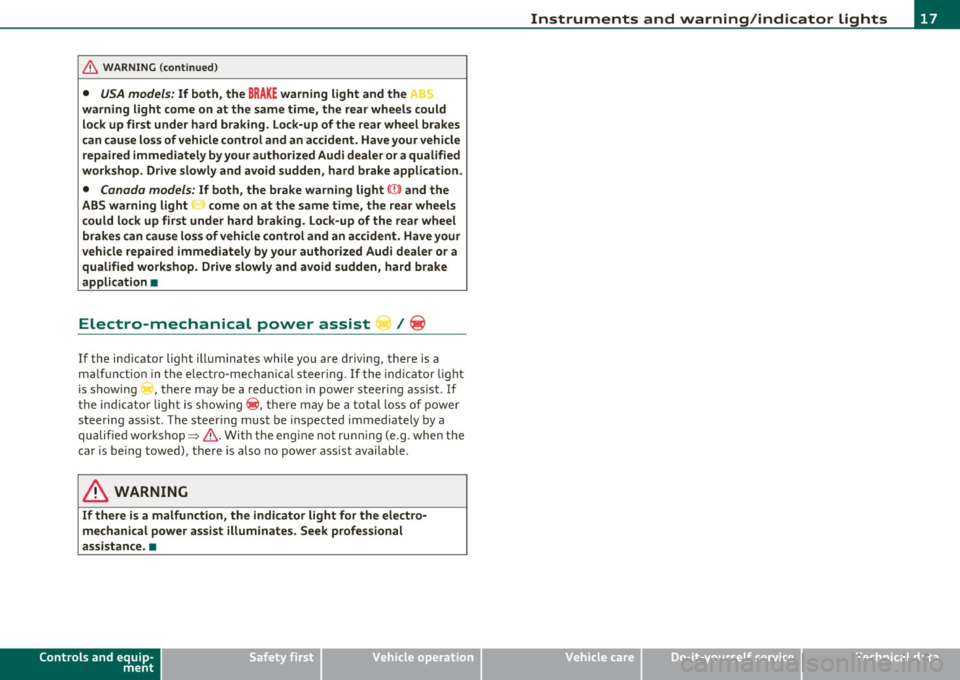
& WARNING (continued)
• USA model s: If both , the BRAKE warning light and the C
warning light come on at the sam e time, the rear wheels could
lock up first under hard brak ing. Lo ck-up of the rear wheel brakes
can cause los s of vehicle control and an accident. Have your vehicle
repaired immediately by your authorized Audi dealer or a qualified
workshop. Drive slowly and avoid sudden, hard brake appli cation .
• Canada models : If both, the brake warning light
ABS warning light
J come on at the same time, the rear wheels
could lock up first under hard b raking. Loc k-up of the rear wheel
brake s can cause loss of vehicle control and an accident . Have your
veh icle repaired immediately by your authorized Audi dealer or a
qualified workshop. Drive slowly and avoid sudden, hard brake
application •
Electro-mechanical power assist /@
If the ind icator light illuminates while you are d riving, there is a
m alfu nction in the ele ctro-mech anical steering . If the ind ic a tor ligh t
is showing , there may be a reduction in power steer ing ass ist . If
t he indi cato r light is sh owing @, there may be a tot al loss o f power
steeri ng assist . The stee ring must be inspected immediately by a
qualif ie d workshop =>
&-With the engi ne not running (e.g. when the
car is be ing towed), t he re is also no power ass ist available.
& WARNING
If there is a malfunction , the indicator light for the electro
mechanical power a ssist illuminate s. Seek professional
assistance. •
Controls and equip
ment Safety first
Instruments and warning
/indicator lights
Vehicle care Technical data
Page 34 of 320
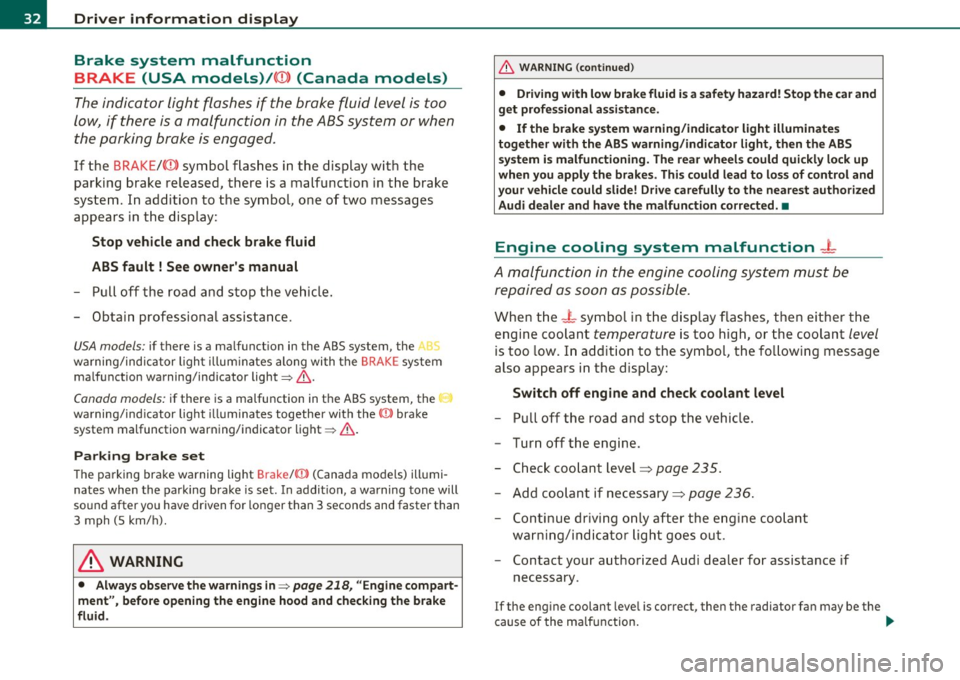
Driver information display
Brake system malfunction
BRAKE (USA models)/ {©) (Canada models)
The indicator light flashes if the brake fluid level is too
low , if there is a malfunction in the ABS system or when
the parking brake is engaged.
If the BRAKE /((D) symbol flas hes in the display wit h the
parking brake released, there is a malfunction in the brake
system. In addition to the symbol, o ne of two messages
appears in the display:
Stop vehicle and check brake fluid
ABS fault ! See owner's manual
- Pull off the road and sto p the ve hicle.
- Obtain professio nal assistance .
USA models: if there is a ma lfunct io n in the ABS system, the/.
w ar ning/ind ica tor ligh t illum inates along wi th the BRAKE system
ma lf u nction warning/indicator light~&.
Canada models: if there is a malfu nction in the ABS system, the
wa rning/ind icator ligh t illuminates togethe r with the ((i)) bra ke
system malfunction warn ing/indicator light~& .
Parking brake set
T he parking bra ke warning light Brake/((i)) (Canada mo dels) ill umi
nates when the pa rking brake is set. In addit ion, a warning tone will
so und after yo u have driven for longer than 3 secon ds and faster than
3 mph (5 km/h).
& WARNING
• Always observe the warning s in ~ page 218 , "Engine compart
ment" , before opening the engine hood and checking the brake
fluid.
& WARNING (c on tinued )
• Driving with low brake fluid i s a safety hazard! Stop the car and
get profe ssional assistance .
• If the brake sy stem warning/indicato r light illuminates
together with the ABS warning /indicator light, then th e ABS
system is malfunctioning. The rea r wheels could quickly lock up
when you apply the brakes . Th is could lead to lo ss of control and
your vehicle could slide! Dri ve carefully to the nea rest authorized
Audi dealer and hav e the malfunction corrected. •
Engine cooling system malfunction _L
A malfunction in the engine cooling system must be
rep aired as s oon as possible .
When t he -L symbol in th e d isplay flashes , then either the
engine coolant
temperature is too h igh , or the coolant level
is too low. In add it ion to the symbol , the fo llow ing message
also appears i n the d isplay:
Switch off engine and check coolant level
- Pull off th e road and stop the v ehicle.
- Tur n off the engine .
- Chec k coo lant level~
page 235 .
-Add co olan t if ne cessary ~ page 236.
-Con tinue drivi ng o nly a fter the e ngin e coolant
wa rnin g/ind icato r lig ht go es out .
- Con tact you r au tho rized Audi dealer fo r assis tance if
necessary .
If the eng ine coolant leve l is correct, then the radiator fa n may be the
c ause of the m alfun ction.
~
Page 134 of 320
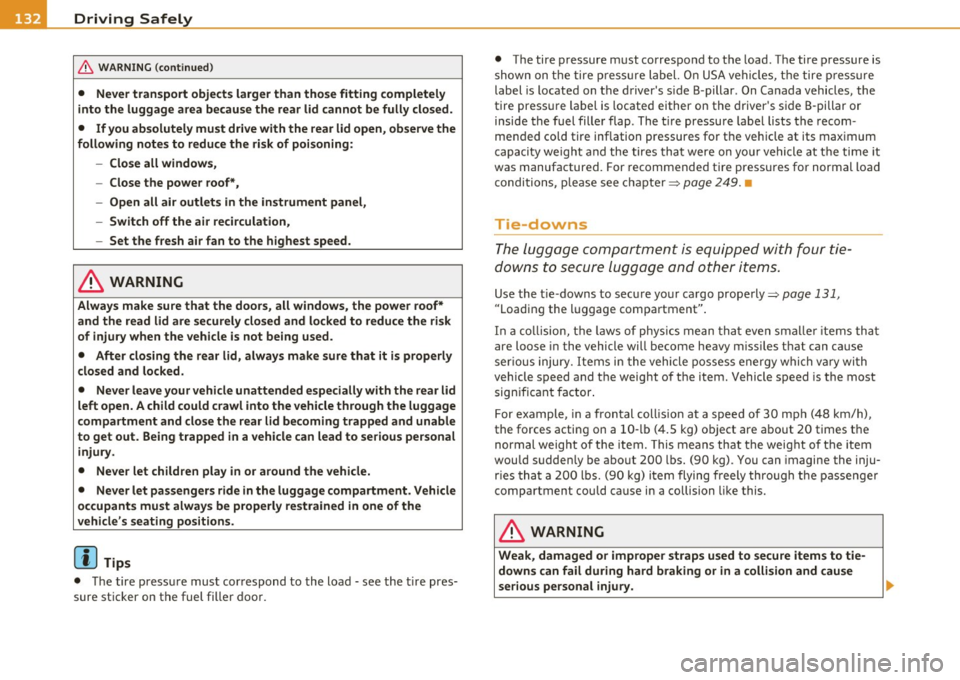
-L_!:D~ r!:_! i~v ~in ~ g~S~ a.!_fe ~ LyL __________________________________________ _
& WARNING (conti nu ed )
• Never tran sport object s larger than those fitting completely
into the luggage are a because the rear lid cannot be fully clos ed.
• If you absolutely must dri ve with the rear lid open , observe the
following note s to reduce the risk of po isoning:
- Clo se all windows,
- Close the power roof*,
- Open all air outlets in the instrument panel,
- Switch off the air recirculation ,
- Set the fresh air fan to the h ighest speed.
& WARNING
Always make sure that the doors , all windows, the power roof*
and the read lid are securely closed and lo cked to redu ce the ri sk
of inju ry when the vehicle is not being used.
• After closing the r ear lid, always make sure that it is properly
closed and locked.
• Never leave your vehicle unattended especially with the rear lid
left open. A child could crawl into the vehicle through the luggage
compartment and close the rear lid becoming trapped and unable
to get out. Being trapped in a vehicle can lead to serious personal
injury.
• Never let children play in or around the vehicle.
• Never let passengers ride in the luggage compartment . Vehicl e
occupants must alway s be properly restrained in one of the
vehicle 's seating positions.
00 Tips
• The tire pressu re mus t cor respond to the load - see the tire pres
sure st icker on th e fuel filler doo r. •
The tire pressure must correspo nd to the load . The tire p ressure is
shown on t he tire press ure label. O n USA ve hicl es, t he tire press ure
label is located on the d river's s ide B-pillar. On Canada vehicles, the
tire press ure label is located either on the driver 's side B -pillar or
inside the fuel fille r flap . The t ire pressure labe l lists the recom
mended co ld ti re inflation pressures for t he ve hicle at its maximum
c apacity weight and the tires that were on yo ur vehicle at the ti me it
was manufactured. For recommended tire pressures for normal load
c ondi tions, p le ase see cha pte r=>
page 249. •
Tie-downs
The lugg ag e co mportment is equipped with four tie
downs to secure lugga ge and other items.
Use the t ie-downs to sec ure your ca rgo prope rly=> page 131,
"Loading the luggage compartment" .
In a co lli sion, t he laws of phys ics mean tha t even sma ller i tems th at
are loose in the vehicle will become heavy m issi les t hat can cause
ser ious injury. Items in the vehicle pos sess energy whi ch v ary wi th
vehicle speed and t he weight of the item. Vehicle speed is the most
significant factor .
For exampl e, in a fron tal col lis io n at a speed of 30 mp h (4 8 k m/h),
the forces actin g on a 10 -lb (4.S kg) o bject are about 20 times t he
normal weight o f the item. This means that the weig ht of the item
wou ld suddenly be abo ut 200 lbs. (90 kg) . You can imagine the inju
r ies tha t a 200 lbs. (90 kg) i tem flying freely thro ugh t he p assenge r
compartment could cause in a collision like this.
& WARNING
Weak , damaged or improper straps used to secure items to t ie
downs can fail during hard braking or in a collision and cause
ser ious personal injury.
Page 138 of 320
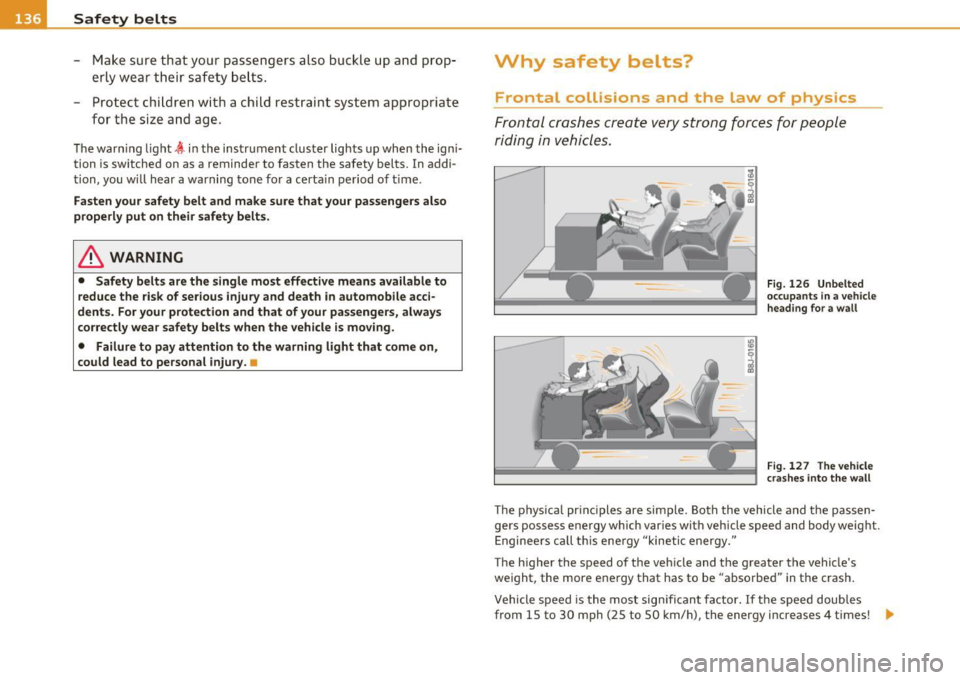
-Safety belts pn, _______________ _
-Make sure that your passengers also buckle up a nd prop
erly wear their safety belts .
- Protect c hildren with a child rest raint system appropria te
fo r the size and ag e.
The warn ing light ~ in the instrument cluster lights up when the igni
tion is sw itched on as a reminder to fasten the safety belts. In addi
tion, you w ill hear a wa rning tone for a certa in period of t im e.
Fasten your safety belt and ma ke sure that your passenge rs also
properly put on their safety belt s.
& WARNING
• Safety belts are the singl e most effective means available to
reduce the risk of serious injury and death in automobile a cci
dents . For your protection and that of your pas senger s, always
co rrectly wear safety belts when the vehicle is mo ving .
• Failure to pay attention to the warning light that come on,
could lead to personal injur y.
u
Why safety belts?
Frontal collisions and the law of physics
Frontal crashes create very stron g forc es for people
riding i n vehi cles.
Fig . 12 6 U nbelted
o ccupa nts in a vehicle
h eadin g for a w all
Fig . 127 The ve hicle
cr as hes int o t he w all
T he p hys ica l pr inc iples are simple. Both the vehicle and the passen
gers possess energy which var ies wit h veh icle speed and body weight.
Enginee rs ca ll t his ene rgy "kinetic energy."
The higher the speed of the veh icle and the greater the vehicle's
we ight, the more energy that has to be "absorbed" in the crash .
Vehicle speed is the most sig nifican t fa ctor. If t he speed doubles
from 15 to 30 mph (25 to 50 km/h), the energy increases 4 times! .,
Page 140 of 320
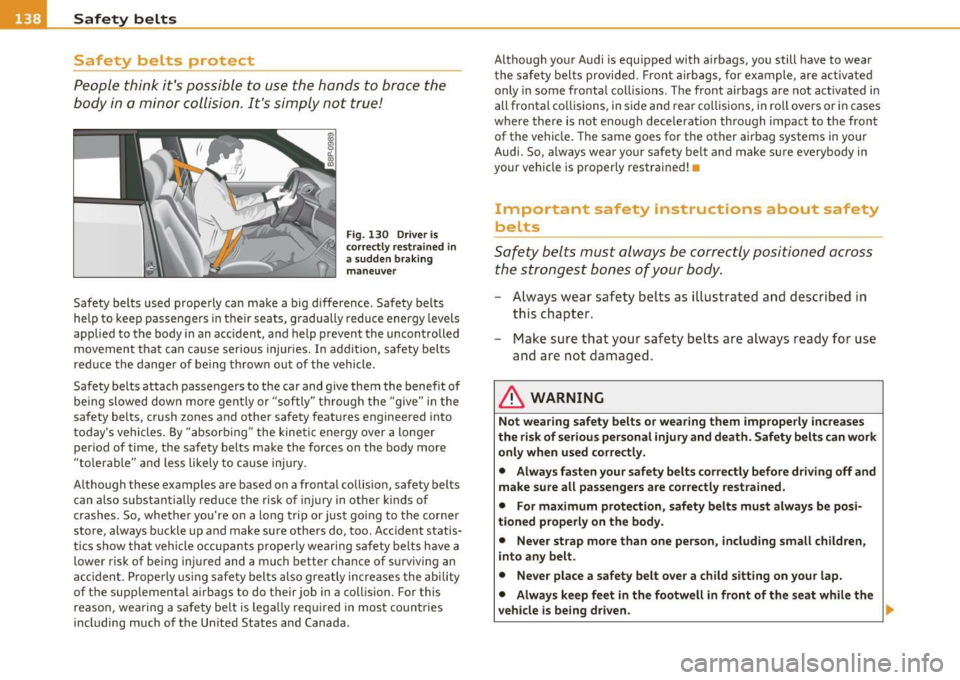
•--=S~a ~f ~e ~t ,z.Y ...: b~ e~lt ~ s~ --------------------------------------------
Safety belts protect
People think it's possible to use the hands to brace the
body in a minor collision . It's simply n ot true!
F ig . 1 30 Driv er is
c o rr ect ly res trai ned i n
a su dden bra kin g
m ane uver
Safety belts used prope rly can make a big difference. Safety belts
help to keep passengers in their sea ts, gradually reduce energy leve ls
applied to the body in an accident, and help prevent the uncontrolled
movement that can cause serious injuries . In add it io n, safety bel ts
red uce the danger of be ing t hrown out of the vehicle.
Sa fety be lts attach passengers to the car and give them the benefit of
being slowed down mo re gently or "softly" through the "give" i n the
safety belts, crush zones and other safety features engineered into
t oday 's vehicle s. By "absorb ing" the kine tic e nergy over a lo nger
period of time, the safety belts make the forces on the body more
"tolerable" and less likely to ca use inju ry.
Although these examples are based on a frontal collision, safety belts can a lso s ubstantially red uce the risk of i nju ry in other kinds of
cr ashes . So, whet he r you're on a long trip or just going to the corner
store, always b uckle up and make sure others do , too. Accident statis
t ic s show that vehi cle occupan ts properly wea ring safety belts have a
lower risk of being injured and a much better chance of surviv ing an
a cc iden t. Properly usi ng s afe ty belts also greatly in cre ases the ability
of the supp lemental airbags to do their job in a collision. For this
reaso n, wea ring a sa fety belt is lega lly req uired in mos t countries
including much of the Un ited States and Canada . Altho
ugh your Audi is equ ipped with a irbags, you still have to wear
t he s afe ty belts provided. Fron t air bags, for ex ample, are a ctiv ate d
only in some fronta l collisions . T he front a irbags a re not act ivated in
all frontal co llisions, in s ide and rear coll isio ns, in roll overs or in cases
where there is not enough decelerat ion thro ugh impact to the front
of the vehicle . The same goes for the other airbag systems in yo ur
Audi. So, always wea r you r safety be lt and make su re everybody in
your vehicle is proper ly restrained!
Important safety Instructions about safety
belts
Safety b elts must always be correctly positioned across
the strongest bones of your body.
- Always wear safety belts as illustrated and described in
this chapter.
- Make sure that your safety belts are always ready for use and are not damaged.
& WARNING
Not wea ring safety belts o r wearing them improperly inc reases
the risk of s eriou s personal injury and death . Safety belts can work
only when u sed correctl y.
• Alway s fasten your safety belts correctly bef ore driving off and
make sure all passengers are corre ctly restrained.
• For ma ximum protection , safety belts must alw ays be posi
ti oned properly on the body.
• Never strap more than one person , including small children ,
into any belt .
• Never place a safety belt o ver a ch ild sitting on your lap .
• Alway s keep feet in the footwell in front of the seat while the
vehicle is being driven.
~
Page 152 of 320

........ _A_ i_rb _ a_,g,:;._ s_, y'- s_ t_e _m ________________________________________________ _
& WARNING (conti nued)
• Airbag work mo st effectivel y when us ed with p roperly worn
safety belts .
• Therefore, always wear your safety belts and make sure that
everybody in your veh icle is properly restrained .
& WARNING
A person on the front passenger seat , especially infants and small
c hildren, will receive seriou s injuries and can even be killed by
being too close to the a irbag when it inflates.
• Although the Advanced Airbag System in your vehicle is
designed to turn off the front passenger a irbag if an infant or a
small child is on the front passenger seat, nobody can absolutely
guarantee that deployment under these special conditions is
impossible in all conceivable situations that may happen during
the useful life of your vehicle.
• The Advanced Airbag System can deploy in a ccordance with the
" low risk" option under the U.S. Federal Standard if a child that is
hea vier than the t ypical one-year old child is on the front
passeng er seat and the other condition s for airbag deployment
are met.
• Accident statistics have shown that children are generally safer
in the rear seat area than in the front seating position .
• For their own safety, all children , especially 12 years and
younger, should always ride in the back properly res trained for
their age and size. •
Advanced front airbag system
Your vehicle is equipped with a front Advanced Airbag System in
compliance wit h Unit ed St ates Fe d er al Motor Vehi cle Safe ty Standar d
208 as applicab le at the time your vehicle was manufactured . The front Advanced A
irbag System supplements the safety belts to
prov ide ad ditional prote ct ion for th e d river's and front passenger's
heads and uppe r bodies in fro nta l crashes. The ai rbags i nflate only in
fronta l impacts when the vehicle dece leration is high enoug h.
Th e front Adva nced A irbag Sys tem for the fron t seat oc cupan ts is not
a s ubstitute for your safety be lts. Rathe r, it is part o f the overall occu
p an t restr aint sy stem in y our ve hicl e. Always remembe r that the
airbag system ca n only help to protect you, if you are sitting upr ight,
we aring your sa fe ty be lt and we aring it prope rly. T his is why you and
your passengers must always be properly restra ined, not just because
t he law requires you to be.
Th e A dvan ced A irbag Syst em in your veh icle has been c ertified to
meet the "low r isk" req uir ements fo r 3 an d 6 year-old c hildren on the
pas senge r side and ve ry small ad ults o n the dr ive r side. T he low r is k
dep loyment cr iteria a re intended to help reduce the risk of injury
t hroug h in teraction wi th the front a irbag tha t can oc cur, fo r ex am ple,
by being too close to the steering wheel and instrument panel whe n
t he air bag i nflates .
In add it ion , the system has been cert ified to comply with t he
"supp ression" requirements of the Safety Standa rd, to t urn off the
front airbag for infants 12 mont hs old and young er w ho are
restrained on the front passenger seat in child restra ints that are
listed in the Standard=>
pag e 169 .
"Suppression" requires the front airbag on the passenger side to be
tur ned off if :
• a ch ild up to about one yea r of age is restra ined on the fron t
passenge r seat in one o f th e rear -facing or forward- facing infant
restraints listed in Federa l Motor Vehicle Saf ety St andar d 208 w it h
w hich the Advanced A irbag System in yo ur vehicle was ce rtif ied. Fo r a
lis ting of the chil d res trai nt s t hat were u sed to certify your vehicle' s
compliance with the US Safety Standard =>
page 169,
• weigh t less t han a thres ho ld level stored in the cont ro l un it is
detected on the front passenger seat.
W hen a perso n is de te cte d on t he fro nt pas senger se at, weigh ing
more than the tota l weight of a child that is about 1 year o ld